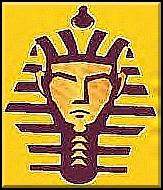Senusret III (Sesostris III in greek), 1878-1843 BCE, fixed Egypt's southern border above the second cataract of the Nile. He also waged campaigns aimed at combating the Libyans of the Western Desert and retaining Egyptian influence and trade ties with Syria and Canaan. He supervised the design and construction of numerous public works and curbed the power of the nobility. These efforts led to an ever greater centralisation of the administration and concentration of power in the capital, with an accompanying growth of well-being, and a decline of the provinces.
The pharaoh who Manetho described as a 'Great Warrior', and also mentions that the king was of unusual height - '4 cubits 3 palms and 2 fingers breadth' (over 6ft 6in - 2m).
There is much evidence to suggest that Sesostris III was more military active than his 12th Dynasty predecessors, although much of this activity was against Nubia rather than Egypt's more northerly neighbours. He was to attack Nubia in several occasions - Year 8, 12 and 15 especially (the Nubians had gradually moved pass the border of the 3rd Cataract, given impetus by the two previous kings' lack of military activity). In Year 8, to facilitate the speed of his fleet attacking the Nubians, he repaired and widened a canal which bypassed the First Cataract of the Nile (this canal had originally been built in the Old Kingdom).
He who protect Egypt is my brother and he who does not is my enemy ~ Sesostris III warrior Pharaoh
HIS STATUES ARE FILLED WITH EMOTIONS UNLIKE ANY OTHER PHARAOH STATUES, HIS STATUES SHOWS THAT HE WAS A WAR VETERAN AND SAW HOW HIS SOLDIERS DIED AND KILL.
The army of Egypt led by Sesostris III againts the Curmins (the pupil hunters named by the babylonians because they can hit a person's iris with a bow and arrow)
